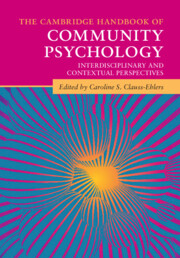Book contents
- The Cambridge Handbook of Community Psychology
- The Cambridge Handbook of Community Psychology
- Copyright page
- Dedication
- Contents
- Figures
- Tables
- Contributors
- Foreword
- Part I Foundational Concepts
- Part II Research, Assessment, and Program Evaluation
- Part III Community Psychology in Action
- 10 Women and Leadership
- 11 Community Resilience
- 12 Building Community Resilience and Supporting Disaster Risk Reduction through Social Action Efforts
- 13 The Consumer Recovery Movement in the United States
- 14 Taking Back the Streets
- 15 Promoting Adolescent Mental Health
- 16 Gowanus Canal and Public Policy
- 17 Family Support Services at Ronald McDonald House Promotes Healing of Seriously Ill Children
- 18 Community Psychology and a Fresh Look at Faith Healing Camps
- 19 Community Impact of Social Media
- 20 Supporting Communities through Educational Access
- 21 Psychological Impact of Climate Change on Communities
- 22 Optimal Local Government and Public Service Provision
- 23 A Public Health Approach to Delinquency and Incarceration
- 24 Public Service Organizations and Community Empowerment
- 25 Women and Immigration
- 26 Community-Based Transition Interventions for Adolescents and Young Adults with Neurodevelopmental Disabilities
- 27 Mental Health on College Campuses
- 28 LGBTQ+ Communities
- Part IV Where Do We Go from Here?
- Index
- References
22 - Optimal Local Government and Public Service Provision
from Part III - Community Psychology in Action
Published online by Cambridge University Press: 16 December 2021
- The Cambridge Handbook of Community Psychology
- The Cambridge Handbook of Community Psychology
- Copyright page
- Dedication
- Contents
- Figures
- Tables
- Contributors
- Foreword
- Part I Foundational Concepts
- Part II Research, Assessment, and Program Evaluation
- Part III Community Psychology in Action
- 10 Women and Leadership
- 11 Community Resilience
- 12 Building Community Resilience and Supporting Disaster Risk Reduction through Social Action Efforts
- 13 The Consumer Recovery Movement in the United States
- 14 Taking Back the Streets
- 15 Promoting Adolescent Mental Health
- 16 Gowanus Canal and Public Policy
- 17 Family Support Services at Ronald McDonald House Promotes Healing of Seriously Ill Children
- 18 Community Psychology and a Fresh Look at Faith Healing Camps
- 19 Community Impact of Social Media
- 20 Supporting Communities through Educational Access
- 21 Psychological Impact of Climate Change on Communities
- 22 Optimal Local Government and Public Service Provision
- 23 A Public Health Approach to Delinquency and Incarceration
- 24 Public Service Organizations and Community Empowerment
- 25 Women and Immigration
- 26 Community-Based Transition Interventions for Adolescents and Young Adults with Neurodevelopmental Disabilities
- 27 Mental Health on College Campuses
- 28 LGBTQ+ Communities
- Part IV Where Do We Go from Here?
- Index
- References
Summary
The optimal size of government for the provision of public services is a question almost as old as the institution of government itself. One answer to the question is that government needs to be big enough to ensure that it can be both autonomous and self-sufficient. Another answer is that government needs to be large enough to capture efficiencies in service production. Neither answer is wholly satisfactory, in large part because they fail to specify how the common good is to be balanced against the need to preserve human dignity. In this chapter I first review the problems with extant arguments relating to the optimal size of government for public service provision before turning to a potential resolution to the problem which puts the person at the center of the quest for optimal local government. I then examine the most commonly executed reforms employed to alter the size of local governments before considering some public policy alternatives that might be more in keeping with an attempt to balance the common good against human dignity.
Keywords
- Type
- Chapter
- Information
- The Cambridge Handbook of Community PsychologyInterdisciplinary and Contextual Perspectives, pp. 451 - 467Publisher: Cambridge University PressPrint publication year: 2021

